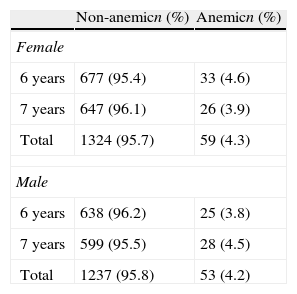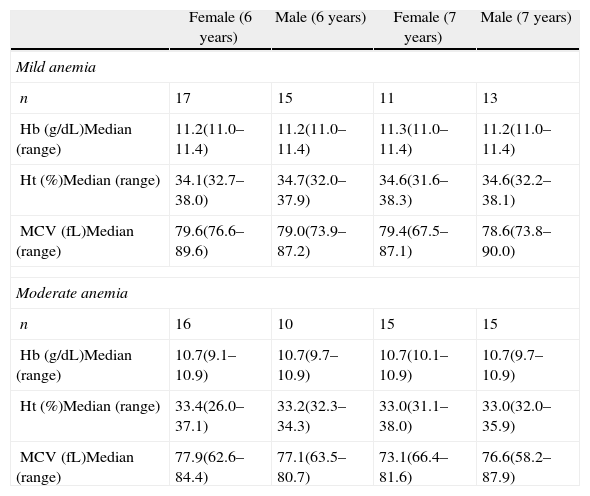Anemia has a great impact on cognitive development and physical growth in preschool-aged children.1 In Brazil, anemia rates in children vary according to region, age group and sample.2–4
The present study measured the prevalence of anemia in a representative sample of 2673 schoolchildren enrolled in the first and second grades (6 and 7 years old) of 40 schools in the city of São José dos Campos, State of São Paulo. The study used data from the Pincel Mágico program5 which counts on the support of the Health and Education Departments. The program aims to identify signs, pathological tendencies or established diseases as well as to promote better health conditions in the school environment. The methods of this program, including procedures, sample design, blood collection and ethical aspects, have been described previously.5 The World Health Organization (WHO) criteria were used to define anemia (hemoglobin<11.5g/dL) and assess the severity.6 The study was approved by the Research Ethics Committee of the Universidade Paulista (UNIP) (#402630).
The total prevalence of anemia in this sample was 4.2% with similar values being found between 6-year old and 7-year-old children (Table 1). With regard to the anemic group, mild and moderate classifications of anemia were distributed equally between males and females in both age groups. Moreover, the median values of mean corpuscular volume were lower than 80fL in all groups (Table 2).
Hemoglobin (Hb), hematocrit (%) and mean corpuscular volume (MCV) levels in mild and moderate anemia groups according to gender and age.
| Female (6 years) | Male (6 years) | Female (7 years) | Male (7 years) | |
| Mild anemia | ||||
| n | 17 | 15 | 11 | 13 |
| Hb (g/dL)Median (range) | 11.2(11.0–11.4) | 11.2(11.0–11.4) | 11.3(11.0–11.4) | 11.2(11.0–11.4) |
| Ht (%)Median (range) | 34.1(32.7–38.0) | 34.7(32.0–37.9) | 34.6(31.6–38.3) | 34.6(32.2–38.1) |
| MCV (fL)Median (range) | 79.6(76.6–89.6) | 79.0(73.9–87.2) | 79.4(67.5–87.1) | 78.6(73.8–90.0) |
| Moderate anemia | ||||
| n | 16 | 10 | 15 | 15 |
| Hb (g/dL)Median (range) | 10.7(9.1–10.9) | 10.7(9.7–10.9) | 10.7(10.1–10.9) | 10.7(9.7–10.9) |
| Ht (%)Median (range) | 33.4(26.0–37.1) | 33.2(32.3–34.3) | 33.0(31.1–38.0) | 33.0(32.0–35.9) |
| MCV (fL)Median (range) | 77.9(62.6–84.4) | 77.1(63.5–80.7) | 73.1(66.4–81.6) | 76.6(58.2–87.9) |
Although based on cross-sectional data, our results suggest lower prevalence of anemia in this age range. Similar data were found by Martins et al.5 In contrast, Costa et al.2 demonstrated that 6- and 7-year-old children attending public preschools in Ilhabela, State of São Paulo had estimates of prevalence of 23.4% and 24.3%, respectively. In addition, Brito et al.3 showed that 36% of children with ages ranging from seven to nine years had anemia in the city of Jequiá (northeastern region of Brazil). Moreover, in a population-based study designed to measure the prevalence of anemia in a healthy population of children from the State of Rio Grande do Sul (southern Brazil) the prevalence of anemia among over 6-year olds was 31%.4
Reports have found many risk factors for anemia in preschool-aged children including socioeconomic level, nutrition, healthcare and biological factors; iron deficiency is considered an important cause of anemia in preschool-aged children.7 We observed a higher proportion of microcytic anemia with these findings suggesting a possible association with iron deficiency. This issue requires further investigation.
Conflicts of interestThe authors declare no conflicts of interest.








